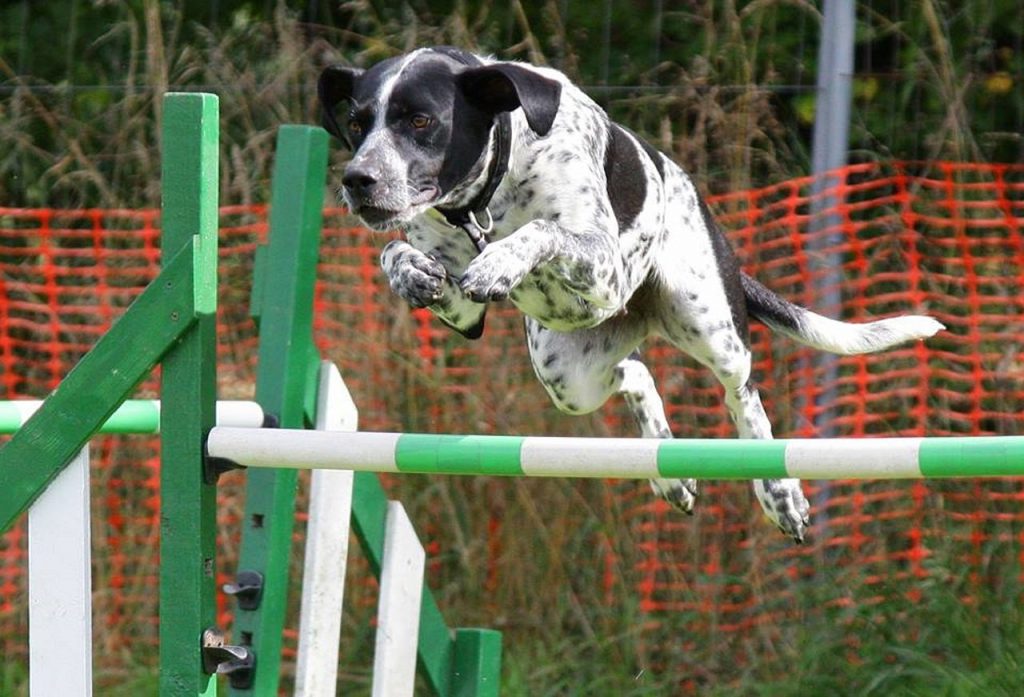Back injuries are a common cause of decreased performance and lameness in agility dogs. While some injuries are more obvious in nature, any unexplained drop in performance, or subtle lameness without an obvious orthopedic diagnosis, warrants further examination for a spinal cause.
A survey of 1600 agility dog owners found that back injuries were the second most common injury (behind shoulder injuries) and accounted for 18% of all agility injuries. Border Collies were most likely to be injured with 13% of their injuries affecting the back. Shetland Sheepdogs and Australian Shepherds were the 2nd and 3rd, respectively. These breeds also had a high incidence of back injuries at 17% and 21%, respectively.
Injuries may include simple mechanical back pain, as well as disc injuries and intervertebral disc disease (IVDD). For the purposes of this article we’re going to focus on injuries to the low back only.
*While this article focuses on low back injuries in agility dogs, the information is also applicable to other sporting dogs.
Low Back Anatomy in Dogs
The dog’s lumbar spine (low back) is a series of vertebrae (bones) separated by discs (think “jelly doughnut”). These vertebral bones form a tube that protects the spinal cord as it passes through. Each gap between the bones has a nerve root which is where the nerves exit the spinal cord. In the low back these nerves supply the legs and viscera (e.g. bowel / bladder).
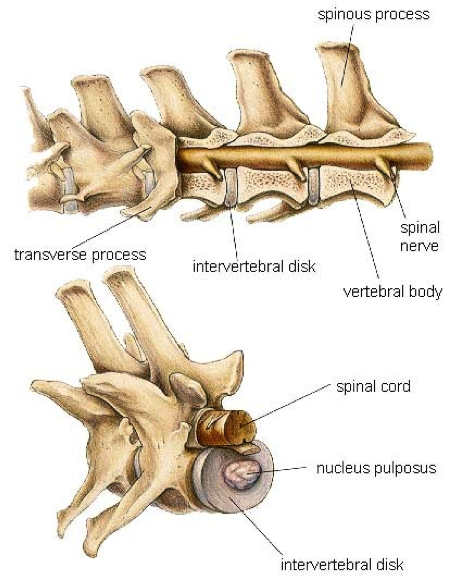
The spine is more susceptible to injury at the transition points. In dogs, this is both the thoracolumbar region (junction between the thoracic spine / rib cage and low back) and the lumbosacral region (junction between the low back and pelvis). These junctions are more prone to injury as it’s where more stable areas (the thoracic spine / rib cage and the pelvis) meet less stable areas (the low back).
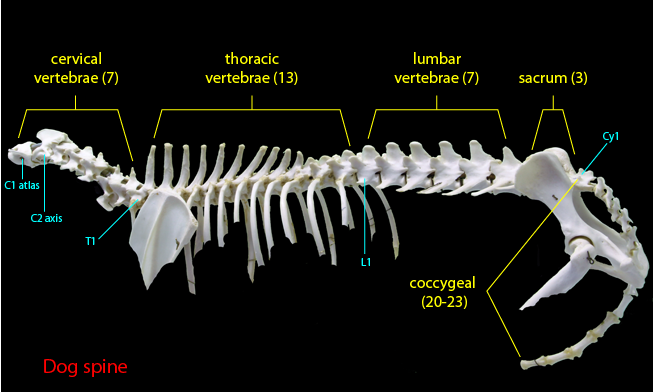
I like to describe the low back like a sailing ship. The mast is the low back. The mast is caught between the sail (thoracic spine / rib cage) and the hull of the ship (the pelvis). You’ve then got all these guide ropes (muscles and ligaments) that try to balance the forces through the mast. If however, there is too much wind, or a ship turns too quickly, the mast can be damaged or snap. This is how the low back can get injured.
Low Back Injuries in Agility Dogs
If the trauma is significant enough there can be catastrophic damage to the low back and rear leg/s. This is usually very obvious and leads to surgery to stabilize the spine and decompress the spinal cord. For the purposes of this article we are focusing on more subtle presentations, rather than significant trauma with obvious low back injury.
Less significant trauma or repetitive microtrauma, like that found in agility sports, may lead to acute injuries or more insidious presentations. This may include simple mechanical back pain, an acute disc injury with or without nerve compression, or internal changes to the disc (IVVD – intervertebral disc disease).
Sciatica
Sciatica is another familiar term associated with the low back and especially nerve compression. Sciatica occurs when the sciatic nerve is irritated as it exits out between the vertebral bones and disc in the low back.
The irritation of the sciatic nerve commonly occurs at the lumbosacral junction due to an injury to a disc (disc prolapse, slipped disc, disc herniation), or through degeneration. When discs are injured they don’t necessarily irritate the sciatic nerve so they don’t always cause issues in the leg. This is called discogenic low back pain.
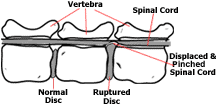
Predisposed Breeds
- Disc degeneration is more common in chondrodysplastic dogs, especially in Dachshunds. Males are 1.5 times more likely to be affected than female dogs.
- German Shepherds (and related breeds) are 8 times as likely to have degeneration with instability in the low back (lumbosacral junction). Border Collies and Labrador Retrievers also have an increased risk (source).
Signs & Symptoms of Low Back Injuries in Agility Dogs
The severity of signs in dogs with low back pain and/or nerve compression can vary a lot. More obvious signs include:
- Reduced appetite & activity
- Flexed (hunched) back
- Weakness or reduced mobility of the rear limbs
- Dragging of one or both rear legs, with possible knuckling
- Incontinence (loss of bowel / bladder control)
- Increased anxiety
- Trembling or shaking
Early signs aren’t necessarily that obvious. In agility dogs you may observe more subtle changes in performance or activities of daily living:
- Missing or declining to jump (e.g. knocking poles or entry / exit from the car)
- Change in jump technique (e.g. tucking the legs in when they used to extend)
- Dipping their head before a jump
- Changes to their turning circle (e.g. not as tight)
- Decreased ability to drive off one or both rear legs
- Reduced stance or stride length (e.g. not extending out through their back legs when running)
- Subtle changes in behaviour (e.g. less tolerant of other dogs in the house)
- Tires more easily / sleeping more
Diagnosis of Low Back Injuries in Agility Dogs
Given the often subtle presentation of low back pain and nerve compression it’s important that a thorough physical examination is completed. The physical examination needs to include both orthopedic and neurological testing of the spine and rear limbs, to rule out conditions like hip dysplasia and cranial cruciate ligament injury.
If injury to the rear limb/s is excluded then scans of the low back may be necessary for a diagnosis. These scans include x-rays, CT, and MRI:
X-rays
A good starting point with a relatively low cost and ease of acquiring. X-rays assess the bones of the spine looking for fractures, degenerative changes, and tumors. While x-rays may suggest changes to disc’s through narrowing of the bony gaps, they can’t diagnose IVDD or disc injury. They don’t assess whether soft tissues like disc material are pressing on the spinal cord or a nerve.
X-rays may appear unremarkable in cases of disc injury and / or nerve compression, especially in younger dogs.
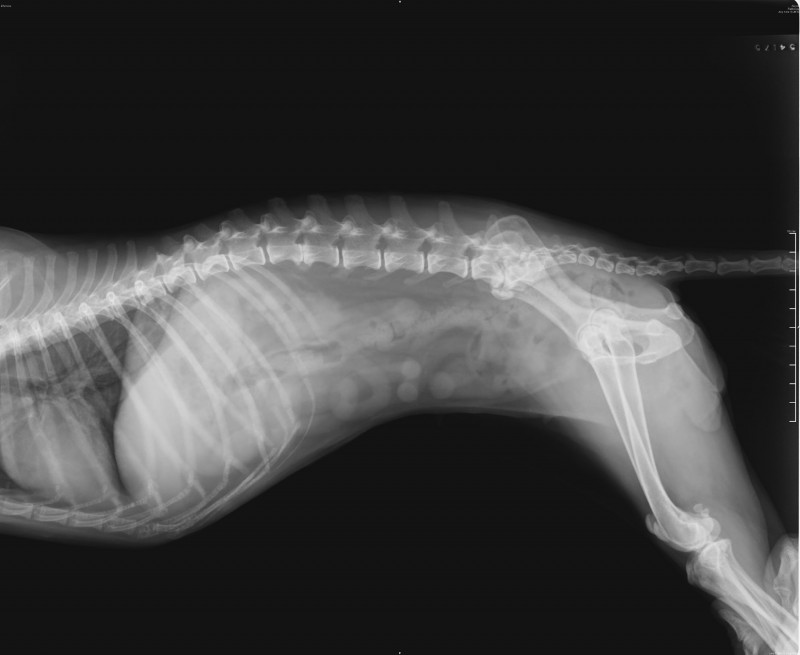
Computed Tomography (CT)
CT scans are similar to x-rays in that they primarily assess bones. CT’s however, assess bones in 3-D with more detail than x-rays. This means they’re better able to identify small fractures and bony lesions. Like x-rays, CT scans are not as good at assessing soft tissues, so while they may be able to give a 3-D representation of space, they can’t diagnose the extent of disc degeneration or disc injury.
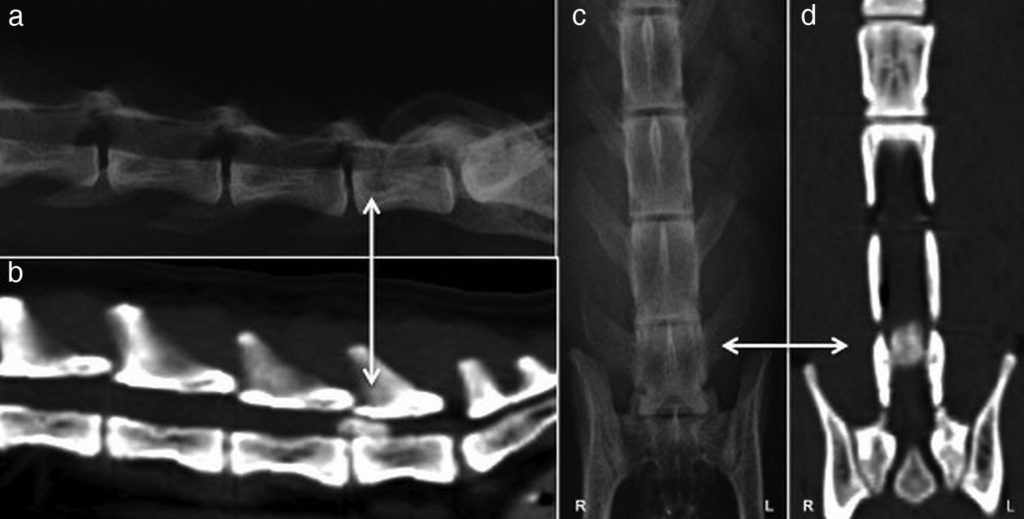
Magnetic Resonance Imaging (MRI)
MRI, in contrast to x-rays and CT scans, provides excellent soft tissue detail. This includes detail of the disc, the spinal cord, and the nerves as they exit the spinal cord. MRI is currently the modality of choice for diagnosing disc degeneration, disc injuries, and nerve compression.

An MRI is Expensive and My Dog Isn’t That Bad?
It’s important to remember that your dog is an athlete and there’s a reason their performance has dropped, even if it’s very subtle. If your dog is not responding to conservative care (e.g. manual therapy, acupuncture, laser therapy, medications etc), or the issue keeps recurring, then an MRI must be considered to confirm whether there is a discogenic cause. With a diagnosis, a treatment / management plan can be developed.
The Risk of Continuing to Train & Compete Without a Diagnosis
If your dog is not responding to conservative therapy with a complete resolution of symptoms, then it’s imperative that you do everything you can to determine an accurate diagnosis. If you haven’t already, this means obtaining scans (including an MRI if disc injury or nerve compression are suspected) to determine the cause of the altered performance.
If a disc prolapse progresses in size and compresses the spinal cord or nerves more, then it can be catastrophic for your dog. Not only will your dog be unable to compete in agility, but they may have significant pain and rear leg lameness.
I know it may not be easy to hear but your dog is an athlete. The demands placed on their bodies far exceed that of a normal dog, and every precaution needs to be taken to make sure they are safe to continue training and competing.
Treatment of Low Back Injuries in Agility Dogs
In simple cases like mechanical low back pain the condition may be self-limiting, with conservative treatment also very effective at helping to achieve a complete resolution and return to pre-injury performance.
If an MRI demonstrates disc changes then treatment will depend on the extent of the presentation (signs and symptoms as well as degree of disc changes).
- In more serious cases surgery may be considered and / or retirement from agility sports.
- In less severe cases conservative treatment (e.g. manual therapy, acupuncture, laser therapy, medications etc) may continue with a rehabilitation program focusing on core strength. Rest will also be important part of any rehabilitation program.
Core Strengthening
Agility places a lot of stress on the low back. The stronger the core muscles are, the better they’re able to protect the low back from the forces placed on it. This includes protection during the slips and twists, as well as the more normal changes in direction, jumping, and stopping / starting.
If you would like more information on the treatment of low back injuries in agility dogs please click here.
Conclusion
Low back pain and sciatica are common causes of decreased performance in agility dogs. If the physical examination and scans have excluded orthopedic conditions in the rear legs then a spinal cause must be considered.
X-rays and CT scans are excellent at demonstrating bony changes in the spine, however they are not the scan of choice for imaging the soft tissues of the low back. An MRI is the diagnostic modality of choice in the diagnosis of disc injury with, or with out, nerve compression.

